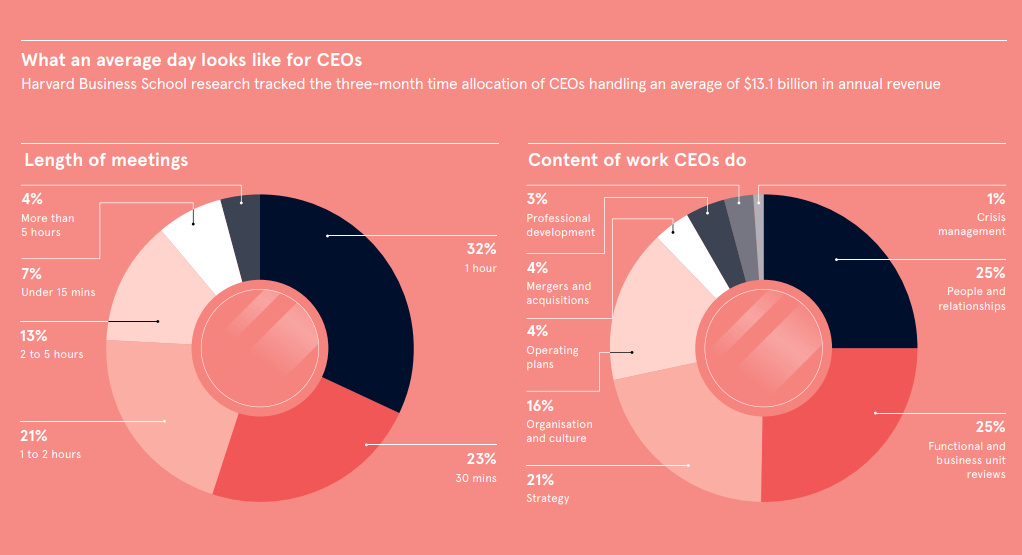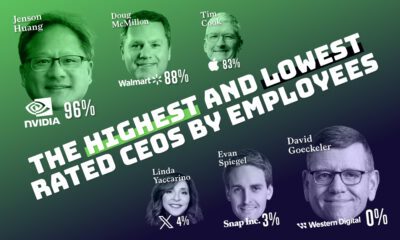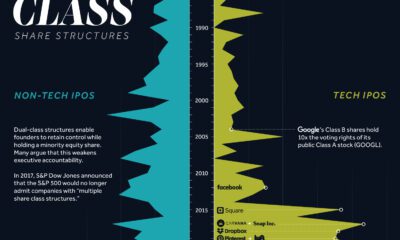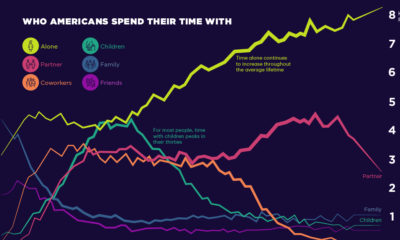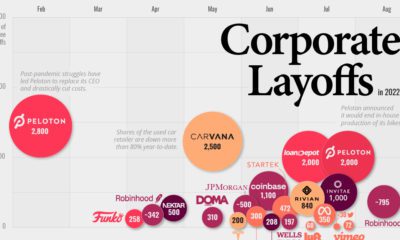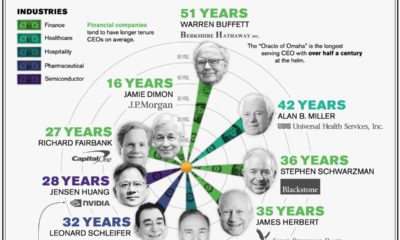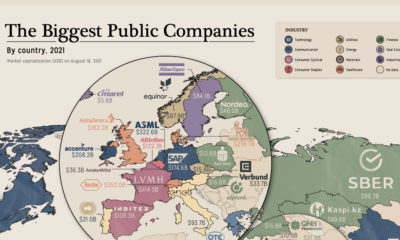Markets
How the CEOs of Multi-Billion Dollar Companies Spend Their Time
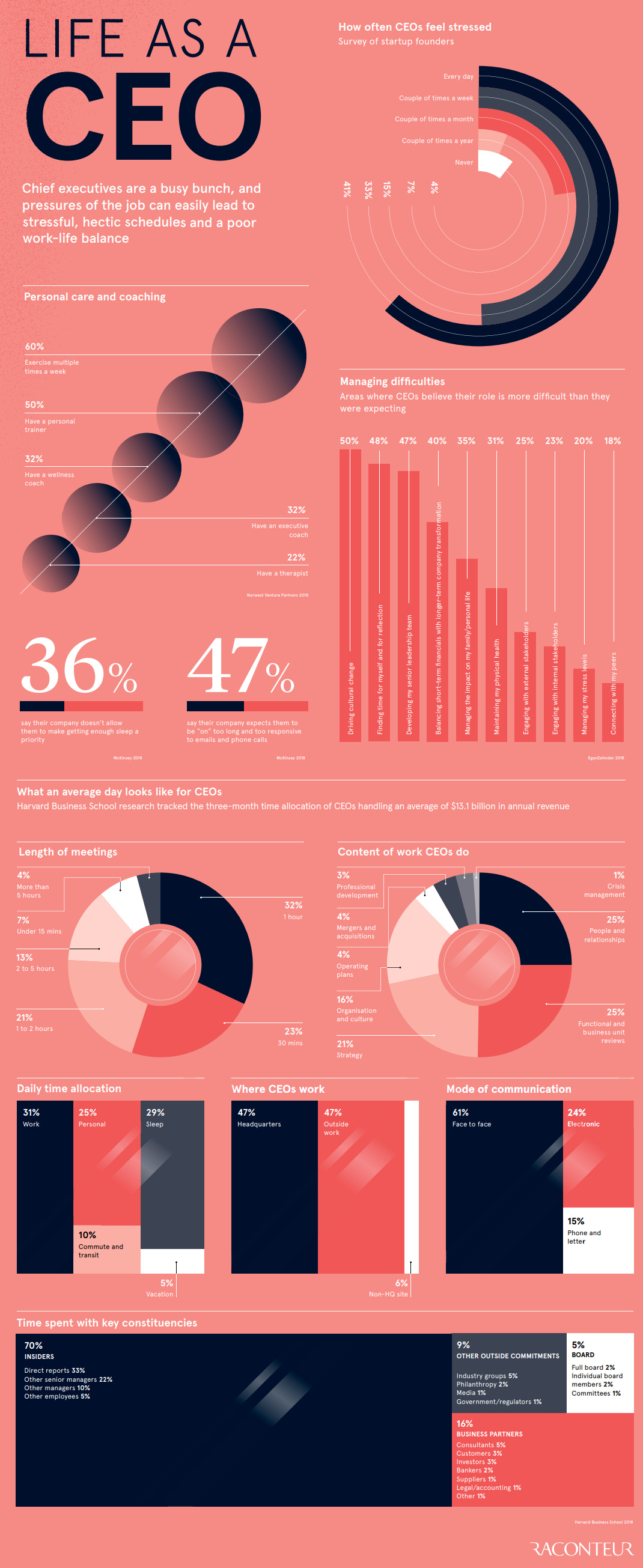
How the CEOs of Billion Dollar Companies Spend Their Time
It’s easy to be envious of the leaders of Fortune 500 companies.
They get paid millions of dollars, and they have the power to make transformative decisions for some of the most beloved companies in the corporate world.
Despite the obvious benefits of being a top CEO, it’s a job that comes with immense pressure, scrutiny, and time commitments. Further, the lack of work-life balance can take a toll on physical and mental health, while putting a considerable strain on relationships.
What’s a day in the life of a CEO like, and how do they deal with the constant demands of the top job?
A Day in the Life
Today’s infographic comes to us from Raconteur, and it breaks down the CEO role in terms of tasks and priorities. It also provides an interesting glimpse at how CEOs tackle the difficulties of the job, while maintaining some semblance of sanity.
To start, we’ll look at how these business leaders allocate their time, according to research from Harvard Business School.
Time allocation of CEOs:
- Functional and business unit reviews (25%)
- People and relationships (25%)
- Strategy (21%)
- Organization and culture (16%)
- Operating plans (4%)
- Mergers and acquisitions (4%)
- Professional development (3%)
- Crisis management (1%)
The above data comes from CEOs who manage companies with an average revenue of $13.1 billion per year, and the focus of these top performers is pretty clear.
About half of time is spent on the analytical side of the spectrum, doing things like evaluating the success of business units or working on company strategy. Roughly the other half of time is spent on people, either on growing relationships or transforming organizational culture.
The Big Challenges
Managing a multi-billion dollar company isn’t without its potential setbacks.
Egon Zehnder’s recent study, “CEO: A Personal Reflection”, identified what CEOs described as the biggest unexpected challenges in their roles:
- Driving cultural change (50%)
- Finding time for myself and for reflection (48%)
- Developing my senior leadership team (47%)
- Balancing short-term financials with longer-term company transformation (40%)
- Managing the impact on my family/personal life (35%)
- Maintaining my physical health (31%)
- Engaging with external stakeholders (25%)
- Engaging with internal stakeholders (23%)
- Managing my stress levels (20%)
- Connecting with my peers (18%)
To deal with the many stresses and challenges of the position, many CEOs have turned to personal care and coaching. In fact, 60% of CEOs exercise multiple times a week, 50% have a personal trainer, 32% have a wellness coach, 32% have an executive coach, and 22% have a therapist.
After all, CEOs know likely more than anyone else that to stay in top form, their minds and bodies need to be performing as well.
Economy
Economic Growth Forecasts for G7 and BRICS Countries in 2024
The IMF has released its economic growth forecasts for 2024. How do the G7 and BRICS countries compare?

G7 & BRICS Real GDP Growth Forecasts for 2024
The International Monetary Fund’s (IMF) has released its real gross domestic product (GDP) growth forecasts for 2024, and while global growth is projected to stay steady at 3.2%, various major nations are seeing declining forecasts.
This chart visualizes the 2024 real GDP growth forecasts using data from the IMF’s 2024 World Economic Outlook for G7 and BRICS member nations along with Saudi Arabia, which is still considering an invitation to join the bloc.
Get the Key Insights of the IMF’s World Economic Outlook
Want a visual breakdown of the insights from the IMF’s 2024 World Economic Outlook report?
This visual is part of a special dispatch of the key takeaways exclusively for VC+ members.
Get the full dispatch of charts by signing up to VC+.
Mixed Economic Growth Prospects for Major Nations in 2024
Economic growth projections by the IMF for major nations are mixed, with the majority of G7 and BRICS countries forecasted to have slower growth in 2024 compared to 2023.
Only three BRICS-invited or member countries, Saudi Arabia, the UAE, and South Africa, have higher projected real GDP growth rates in 2024 than last year.
| Group | Country | Real GDP Growth (2023) | Real GDP Growth (2024P) |
|---|---|---|---|
| G7 | 🇺🇸 U.S. | 2.5% | 2.7% |
| G7 | 🇨🇦 Canada | 1.1% | 1.2% |
| G7 | 🇯🇵 Japan | 1.9% | 0.9% |
| G7 | 🇫🇷 France | 0.9% | 0.7% |
| G7 | 🇮🇹 Italy | 0.9% | 0.7% |
| G7 | 🇬🇧 UK | 0.1% | 0.5% |
| G7 | 🇩🇪 Germany | -0.3% | 0.2% |
| BRICS | 🇮🇳 India | 7.8% | 6.8% |
| BRICS | 🇨🇳 China | 5.2% | 4.6% |
| BRICS | 🇦🇪 UAE | 3.4% | 3.5% |
| BRICS | 🇮🇷 Iran | 4.7% | 3.3% |
| BRICS | 🇷🇺 Russia | 3.6% | 3.2% |
| BRICS | 🇪🇬 Egypt | 3.8% | 3.0% |
| BRICS-invited | 🇸🇦 Saudi Arabia | -0.8% | 2.6% |
| BRICS | 🇧🇷 Brazil | 2.9% | 2.2% |
| BRICS | 🇿🇦 South Africa | 0.6% | 0.9% |
| BRICS | 🇪🇹 Ethiopia | 7.2% | 6.2% |
| 🌍 World | 3.2% | 3.2% |
China and India are forecasted to maintain relatively high growth rates in 2024 at 4.6% and 6.8% respectively, but compared to the previous year, China is growing 0.6 percentage points slower while India is an entire percentage point slower.
On the other hand, four G7 nations are set to grow faster than last year, which includes Germany making its comeback from its negative real GDP growth of -0.3% in 2023.
Faster Growth for BRICS than G7 Nations
Despite mostly lower growth forecasts in 2024 compared to 2023, BRICS nations still have a significantly higher average growth forecast at 3.6% compared to the G7 average of 1%.
While the G7 countries’ combined GDP is around $15 trillion greater than the BRICS nations, with continued higher growth rates and the potential to add more members, BRICS looks likely to overtake the G7 in economic size within two decades.
BRICS Expansion Stutters Before October 2024 Summit
BRICS’ recent expansion has stuttered slightly, as Argentina’s newly-elected president Javier Milei declined its invitation and Saudi Arabia clarified that the country is still considering its invitation and has not joined BRICS yet.
Even with these initial growing pains, South Africa’s Foreign Minister Naledi Pandor told reporters in February that 34 different countries have submitted applications to join the growing BRICS bloc.
Any changes to the group are likely to be announced leading up to or at the 2024 BRICS summit which takes place October 22-24 in Kazan, Russia.
Get the Full Analysis of the IMF’s Outlook on VC+
This visual is part of an exclusive special dispatch for VC+ members which breaks down the key takeaways from the IMF’s 2024 World Economic Outlook.
For the full set of charts and analysis, sign up for VC+.
-

 Markets1 week ago
Markets1 week agoU.S. Debt Interest Payments Reach $1 Trillion
-

 Markets2 weeks ago
Markets2 weeks agoRanked: The Most Valuable Housing Markets in America
-

 Money2 weeks ago
Money2 weeks agoWhich States Have the Highest Minimum Wage in America?
-

 AI2 weeks ago
AI2 weeks agoRanked: Semiconductor Companies by Industry Revenue Share
-

 Markets2 weeks ago
Markets2 weeks agoRanked: The World’s Top Flight Routes, by Revenue
-

 Countries2 weeks ago
Countries2 weeks agoPopulation Projections: The World’s 6 Largest Countries in 2075
-

 Markets2 weeks ago
Markets2 weeks agoThe Top 10 States by Real GDP Growth in 2023
-

 Money2 weeks ago
Money2 weeks agoThe Smallest Gender Wage Gaps in OECD Countries

